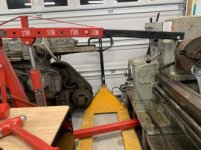Blackrainstorm
Aluminum
- Joined
- Mar 18, 2018
- Location
- Blacksburg, VA
I have this 1967 American “square head” 14x54 lathe sitting in my home shop that needs some fixing. It has a few broken external parts and what not, but the most daunting problem has been removing the rusted L1 chuck with rusted on spindle nut.
1. Buy spanner, put lathe in back gear, no luck
2. Use deadblow hammer on spanner
3. Dog chuck with a 15” Crescent wrench onto casting, use bigger hammer on spanner
4. Dog chuck, use engine hoist and hook on spanner
5. See above, plus heat
6. See above plus soak in Kroil penetrating oil, still no luck
7. See above plus second spanner on opposite side, hit with large hammer Success!
Success!
The nut broke free with enough force that it backed off three threads until it bottomed out on the headstock.




In my experience, very little gives the same feeling of euphoria and invincibility as conquering a seemingly impossible stuck fastener. Kinda sprung my spanner though.
Still organizing and reorganizing my shop. I will post something with more pictures in a week or so.
1. Buy spanner, put lathe in back gear, no luck
2. Use deadblow hammer on spanner
3. Dog chuck with a 15” Crescent wrench onto casting, use bigger hammer on spanner
4. Dog chuck, use engine hoist and hook on spanner
5. See above, plus heat
6. See above plus soak in Kroil penetrating oil, still no luck
7. See above plus second spanner on opposite side, hit with large hammer
 Success!
Success!The nut broke free with enough force that it backed off three threads until it bottomed out on the headstock.





In my experience, very little gives the same feeling of euphoria and invincibility as conquering a seemingly impossible stuck fastener. Kinda sprung my spanner though.
Still organizing and reorganizing my shop. I will post something with more pictures in a week or so.





